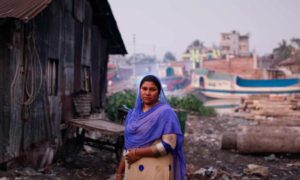
As far back as she can remember, Shahanaz Ali has been running from cyclones. “Moving constantly from one place to another is exhausting,” says Ali. “Nowhere feels like home.” Her family first fled from their house in 1970, when Bangladesh was devastated by Cyclone Bhola – one of the deadliest cyclones in history.
Up to 500,000 people died, including Ali’s grandparents. The largely inadequate response of the ruling Pakistani government towards the cyclone’s Bengali victims in what was then East Pakistan triggered Bangladesh’s war of independence a year later.
Natural disasters continue to shape political and economic life in Bangladesh. Situated on the Ganges-Brahmaputra delta – the world’s largest – the small south Asian country’s unique geography and low-lying topography make it particularly vulnerable to climate change. Yet against the odds, Bangladeshis have adapted as best they can.
Now a new report by the International Centre for Climate Change and Development (ICCCAD), a leading research institute in Dhaka, warns that the country is reaching the limit of its ability to adapt to extreme weather.
Climate events in Bangladesh are increasing at such an alarming rate, it says, that current policies and adaptation strategies will soon not be enough to safeguard the country’s people, infrastructure and ecosystems.
Between 2000 and 2019, Bangladesh experienced 185 extreme weather events, including cyclones, heatwaves, flooding and droughts.
In 2005, Bangladesh was one of the first least-developed countries to develop a national programme of action and has now become recognised as a global leader in adaptation and resilience. Government policy and local initiatives have averted the worst effects and saved millions of lives; the death toll from cyclones alone has fallen from up to 500,000 during Cyclone Bhola in 1970 to 35 during Cyclone Sitrang in 2022.
Prof Mizan Khan, deputy director of ICCCAD and one of the lead authors of the report, says: “The research shows that by the end of the century, even under a very low-emissions scenario, Bangladesh could see a further 0.8C [1.44F] of warming compared with previous decades.
“Heavier rainfall could increase peak river flow by 16% relative to 1971–2000, raising the inevitable risk of flooding and causing further devastation than we are already seeing,” he says.
